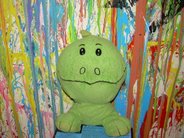One commonly associated deficit in autism is an absence of ‘theory of mind’. The theory of mind or ToM as defined by Premack and Woodruff, who first described this theory in 1978, as the ability to “attribute mental states and to use these invisible postulates to explain behavior in everyday life”( Qtd. In Chari). In a broader definition as described by Encarta MSN.com’s dictionary ToM is “concepts of mental activity: the way somebody conceives of mental activity in others, including how children conceptualize mental activity in others and how they attribute intention to and predict the behavior of others”. The problem with trying to use the ToM exclusively to explain autism is that some major symptoms, such as an inability to imitate other people and delays in or a complete lack of language development seem to either counter or steam from somewhere else completely than the ToM.
To account for this seeming discrepancy we must examine imitation as a precursor for a theory of mind. You must first be able to imitate something; to see someone do and then do yourself, before you are able to breakdown in your own mind the possibility of what and why they have done this, thus being able to understand the doer’s situation and apply it to their own lives. To apply this to a deficit of ToM in autism we can show a deficit in imitation. In 21 studies done, 19 showed at least some level of an inability or unwillingness to readily imitate other humans in autistic individuals. These findings suggest a problem with the ability of the individuals to properly map the actions of others.
Patients with damage to their front left lobe of their brain have shown huge deficits in their ability to imitate actions, though they have the physical ability to. This coincides with the idea that imitation relies on the representations of actions and is associated with the part of the brain that has been damaged in these individuals. This area has been studied in non-human primates and a system of neurons called the mirror neuron system (MN system) has been discovered, which is responsible for coding the actions of the primates. It is not possible to directly study humans in the same way as these primates to show the sure existence of a mirror neuron system in humans, but EEG tests strongly suggest such a discovery.
Mirror neurons involving hand motions in primates are thought to have evolved into speech capabilities in humans, and thus “by acting as a bridge between perceived and performed actions and speech, the MN system is thus suggested to have provided the foundations for the evolution of dialogue”. The mirror neuron system is also associated with the ability to ‘put yourself into someone else’s shoes,’ and as stated earlier, this is associated with the development of a theory of mind.
All of this can be applied in autism by showing a malfunction in the mirror neuron system. I have already discussed the studies described here for showing the disjunction in mirror neurons in autistic individuals so I will not describe them again. (refer to posts 2 and 4 for explanations).
There is no empirical evidence that the existence of a MN system is utilized in imitation and thus the development of a theory of mind and that a dysfunction in the MN system can lead to the autism, but the evidence presented thus far can strongly suggest such a conclusion.
Works Cited:
Chari, Satyan. “The “Theory of Mind” Hypothesis: Explaining Autism”. 2003. 10 Feb. 2007
Encarta World English Dictionary [North American Edition], 2006. Bloomsbury Publishing Plc. 10 Feb. 2007
Williams, J.H.G, Whiten, A, Suddendorf, T, Perrett, D.I. Rev. of Imitation, mirror neurons, and autism. 19 Mar. 2001. 10 Feb. 2007




2 comments:
hmm, I never knew what mirror neurons even were till I read this blog. You give great facts and explain alot of details, but I would also like to hear more on the Theory Of Mind. Nice post.
I am already getting a better idea of what autisim is. I love that you took the time to put up the video in a previous blog. It really explained a lot to me. I also wanted to thank you for the extra help you provided for our paper! I really appreciate it!
Post a Comment